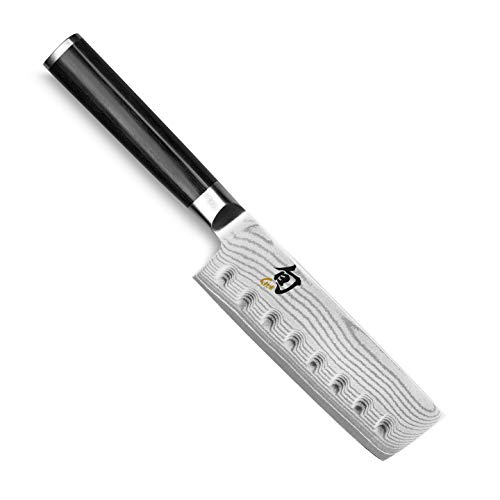The outstanding feature of Japanese knives is its delicacy. They can be used in other specialized applications and in particular kitchen and multi-purpose tasks. Japanese knives are made in likeness to samurai swords with their old-fashioned techniques and design. There are different types of Japanese knives and among its versatility, there is still the point of discussion of Nakiri vs Santoku knives and their overall efficiency.
Nakiri vs Santoku and their Origins
The creation of making swords to making knives began in the 1850s. World War II saw General McArthur banning the production and possession of swords and artisans shifted to crafting kitchen knives. Sakai is a known material present in rifles after its introduction by the Portuguese and is a crucial component in making good quality Japanese knives.
The Nakiri knife came from the 17th century. Its framework is derived from older versions of the vegetable knife that is modified to create thinner and sharper knives. Nakiri (along with the other types Deba and Yagiba) are knives that emerged out of this era.
Santoku
Santoku is a modern type of Japanese knife. It was developed at the end of World War II where there came a merge of Japanese and Western cultures and the locals have developed a tolerance and appreciation of Western ways. Its design is from the cleaver Santoku means “three virtues” or “three uses”. Depending on how useful one wants the knife to be, it narrows down its purpose, sections, and preferred foods into three:
- Uses: chops, dices, and minces
- Sections: tip, edge, and heel
- Preferred food: fish, meat, and vegetables
The length of Santoku blades is 5” to 7” long (as long as a person’s hand) with a flat edge and a blade that curves at around 60 degrees. Its blade is of a sheepsfoot design that serves its purpose as it draws the spine of the knife performing a linear cutting motion. Its stainless steel is harder, thinner, and lighter than a Western knife; other features of the Santoku include a chiseled-tip that is sharpened to one side that has a bevel of 10 to 15 degrees.
Despite the narrowness of its blade, Santoku knives have a minimal risk of unnecessary piercing that maintains a strong downward cut. The Nakiri blade is perfect for different kinds of meat, rough and bigger pieces of fruits and vegetables. It can also be used for transferring food and scooping ingredients. Materials of Santoku knives vary from steel, ceramic or high carbon.
Nakiri
Nakiri Knives are a type of Japanese knife that is multi-purpose but its primary use is for cutting fish and vegetables. Their grip allows easy movement through thin and julienne slices. Its distinguishing characteristic is a long, flat edge. The Nakiri is a knife that specializes in cutting vegetables: the user can control how the vegetables are cut. Herbs, root vegetables, and plump fruits are some of the products that can do with the use of the Nakiri knife. This knife type has its origins in parallel with the cleaver’s shape, hold, and tip, which is flat and blunt.
Unlike the cleaver, however, the Nakiri is thinner and lightweight. Apart from being able to slice complex vegetables, it does equally well with intricate peels, artisan slices, and juliennes. The Nakiri knife has a sensible blade width that serves as a safety feature as it keeps your fingers out of the way when making quick action slicing and dicing. The length of the average Nakiri knife is 5” to 7”; its cutting edge makes for comfortable maneuvering. It functions in the middle of a long knife (for slicing and dicing) and a small knife.
Nakiri vs Santoku and their Key Aspects
The different ways of which to distinguish the Nakiri and Santoku is through their aspects: their convenience, materials used, safety features and usefulness/functionality.
Convenience
Nakiri vs Santoku in terms of convenience has added points when it comes to versatility. The Nakiri is versatile in vegetable cutting since sizes and shapes vary while the Santoku is versatile in terms kitchen purposes for different ingredients.
When it comes to execution, a Nakiri knife can offer a clean cut when it comes to cutting raw produce. This knife type does the job of cutting vegetables specifically well: with most vegetables cut in various sizes. Because it is a simple knife to use, no expertise is needed to master using the knife.
A Santoku knives’ convenience is seen as it is used in the kitchen. They are multi-purpose by nature and traditionally, professional (Japanese) chefs use the knife in a forward/backward or straight and downward chop motion. Beginners can easily use a Santoku knife by slicing and using its flat edge as a guide for making even slices.
Purpose
Both knives are multi-functional. In special instances, the Nakiri knife slices vegetables in multiple ways--from informal cuts to intricate culinary decorations. The Nakiri is specific to fruits and vegetables. Its blade shape allows it to cut vegetables without the risk of damage. Santoku knives excel in multi-tasking with a variety of produce. Fruits, sticky cheese, herbs and different kinds of poultry and meats can be cut using a Santoku though not as effective as other knife types.
Materials Used and Safety Features
European materials are used into Japanese knife design for a more stable and sophisticated performance. Nakiri knives often use stainless steel from either Germany or Damascus. Ergonomic Santoprene material used for the handle is used for steady balance.
A trademark safety feature of the Santoku is an even level of the blade to handle. This is made so that users can maneuver the knife with ease, making cutting easier. The Nakiri’s blade width and blunt, flat tip minimize unnecessary hazards in the kitchen.
Usefulness and Functionality
The comparison of the Santoku vs Nakiri can also be evaluated depending on its shape and blade.
Shape
Both knives are designed to make the user feel experienced. For the Nakiri, a user feels the ease when using the handle and blade while for the Santoku, simply using the knife produces a straight slice.
The Nakiri knife is “entry-level” and perfect for beginners as its comfort and balanced feel on the hand is felt. Its design is modeled after the cleaver. With its curved and thin Granton edges, a Santoku knife has a straight angle that is evident in the even slices that it produces.
Blade
The Santoku deals more with the accuracy of slicing while the Nakiri knife’s use is on the design. A good Nakiri knife is well-balanced. Both knives have the same blade length: an approximate of 5” to 7” inches.
There are three blade components of the Nakiri knife: the length, width, and blunt tip.
- Length - a Nakiri’s blade length ideally fits in a hand’s length. If a blade is too long, there is difficulty maneuvering when asserting pressure to cut ingredients. Too short of a blade and food becomes hard to slice. An average Nakiri knife has a length 5” to 7” inches.
- Width - When used in slicing, the width becomes a safety feature since it does not need to be sharpened for the knife to dig in meat.
Blunt tip - Its tip is as blunt as it is flat. This gives the user a certain amount of control when wanting to produce delicate slices.
The Santoku knife’s functionality depends highly on the blade:
- Blade - The best blade edge for a santoku knife is that of a leveled edge to aid in equal and precise knife cutting. The blade and handle of a Santoku should be of equal weight or else there is a risk of a sore wrist.
- Air pockets (Granton edges) are optional and not a requirement with Santoku knives but when choosing a knife of this kind, it is best to check if the air pockets are close together. This feature allows for even and faster cutting.
Santoku vs Nakiri Knife: Comparison and Contrast
Knife | Knife Features | Current Price | Common Features |
|---|---|---|---|
Blade:
Handle:
|
| ||
Blade: No-stain German cutlery steel made of High-carbon that is not prone to rust, corrosion or discoloration. Durability and strength is based on the Santoku knife’s precise forged construction Handle: Mercer’s balanced tang is an Ergonomic Santoprene handle that offers a comfortable, non-slip grip even if hands are wet.
|
The Final Verdict
Depending on what is important to you, we firmly believe that in the debate between Nakiri vs Santoku, the winner will depend on what is important to you. Both are superior and versatile in their own way and a perfect merger of Japanese and Western cutlery innovation.
The Nakiri knife is ideal for starters in preparation and cooking. Simply balancing the handle and the blade is sufficient enough to make you a professional; the Santoku knife enhances your already-experienced skills in the kitchen. It does, however, give you perfect slices of meat, cheese, and vegetables so it could be a great addition to your collection. Whatever your selection is, we guarantee that its quality is first-star!


